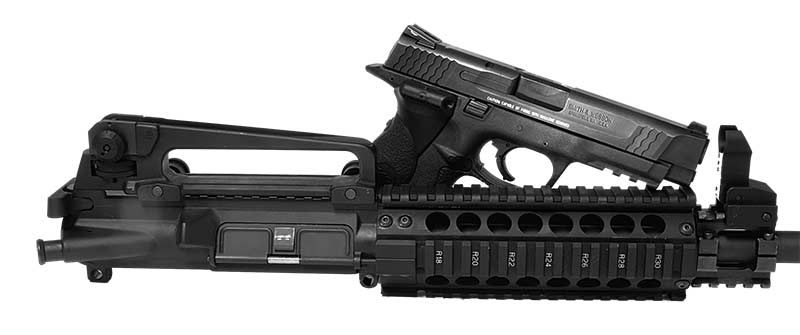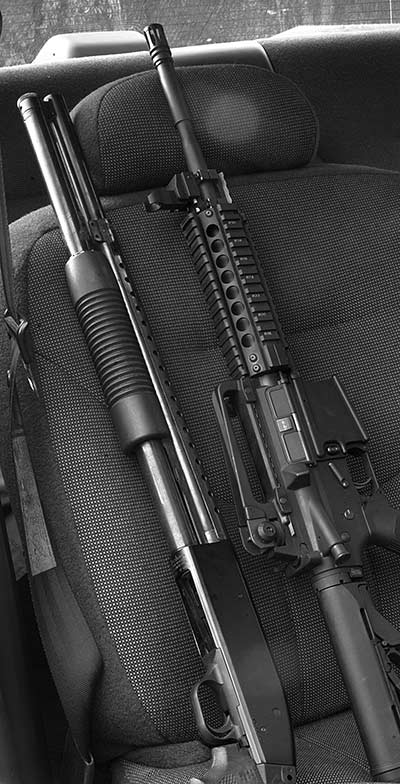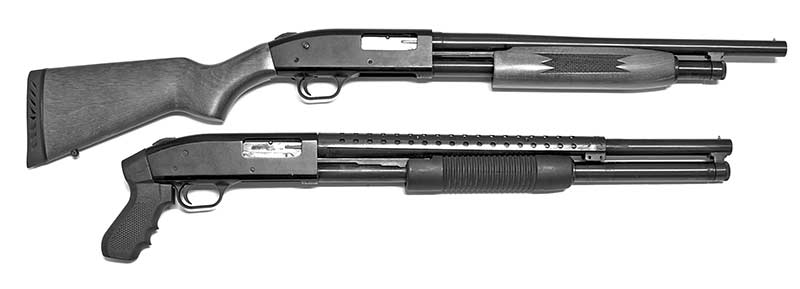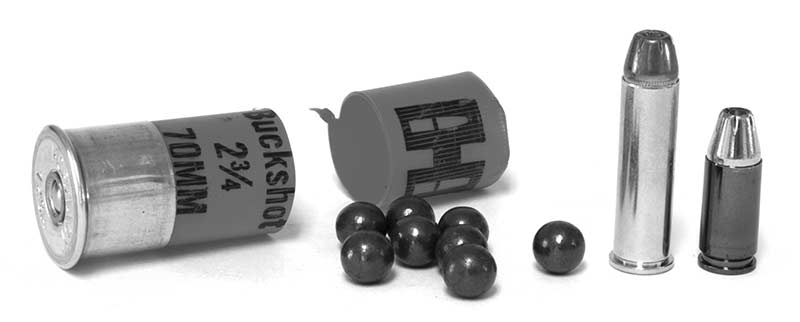For the past 40 years, we’ve always had a ‘car gun’, and, except for the ’12by12′, it’s usually been some form of rifle.
MORE ROOM MORE GUN
RETHINKING THE CAR GUN

One of the places that rifles outshine pistols is the sight radius — note that the sight radius of the AR here, which is short by rifle standards, is still about twice as long as that of this S&W M&P .45 — which is big by pistol standards.
These days, a “car gun” is generally considered to be any reasonably-powered handgun that can be slid under the driver’s seat and left there perpetually, to be rattled and scratched about largely at random — and hopefully be functional if ever needed. Often an inexpensive gun (police trade-in .357s are great for such duty), the owners will usually justify their selection of pistol by describing it as one they don’t mind having stolen. But it hasn’t always been this way. Think back to cowboy movies, did you see a spare Peacemaker holstered on John Wayne’s saddle, or a rifle?
Except for a few pretty hardcore guys, most people with CCW licenses select their carry gun by what they can conceal on their person, often virtually ignoring whether or not the pistol is capable of actually stopping a bad guy. While I think this is backwards, the logic does apply well to cars. Since a vehicle gives you far greater flexibility about what you carry in it, it makes sense to carry more gun in your car than you do on your person. Never forget that Bonnie and Clyde used a BAR — a full-auto .30/06 — as their car gun.
Before we get into the nuts-and bolts of long guns for vehicle defense, let me go ahead and point out that if you’re getting a gun out of your car, or firing one from inside it, you’re in a car, which means you can leave the scene. There aren’t a whole lot of situations where staying put and getting into a rifle fight is a wise — or justifiable — option. The obvious exceptions are when you’re returning to your own home, or where your vehicle is disabled or somehow blocked in. Beyond that, it can get pretty sketchy, so make sure you know your state’s law on weapons and self defense, and follow it.

Either the AR or shotgun — such as this Mossberg 500 — can be easily equipped with a variety of folding, collapsing, or pistol grip stocks that make them much easier to use inside a car.
With that in mind, let’s talk about the two general classes of long guns, which are rifles and shotguns. Both share the great advantages of increased stopping power and hit probability far beyond what a handgun can offer. Power, because shoulder-mounted weapons can simply handle more powerful cartridges than pistols (and do a better job of distributing the recoil), and hit probability because rifles are more accurate than pistols, and easier to shoot well. Much of the shootability comes down to the increased sight radius of the rifles over pistols. The further the front and rear sights are from one another, the more precisely you can align them.
The shotgun is perhaps the definitive defensive weapon. Mostly limited to 50 yards and under, it throws enough lead to end a fight, in a large enough pattern to increase your odds of hitting your target under stress. For example, the standard defensive load for the 12-guage is 00 — “double ought” buckshot — which throws anywhere from eight to a dozen or more pellets that measure .38″ in diameter. For comparison’s sake, that’s about the same as emptying a .357 every time you pull the trigger. Consider that pumps and semiautos are the weapons of choice for self-defense, and it doesn’t take much to see why the 12 gauge has such a fearsome reputation.
Where the shotgun suffers by comparison with the rifle is in its precision, its ability to penetrate things like steel and glass, and in some cases, the number of cartridges it holds. Realistically, a legitimate defensive shooting probably won’t require many rounds, and if someone’s hiding behind a car, you need to be leaving, not shooting at them. But since more and more defensive shootings involve more than one bad guy, be aware than once the flag goes up, there are absolutely no guarantees about what it will take to win the fight, and you may very well have to shoot someone who’s firing at you from behind their car. While the pattern of the shotgun is somewhat more forgiving than the pinpoint accuracy of a rifle, rifles let you put the bullet exactly where it needs to go, which reduces the likelihood of a stray shotgun pellet striking something (or someone) you didn’t intend.
A pair of Mossberg 12 gauge pump shotguns: the full-stocked one on top has an 18″ barrel and holds five rounds, while the one on the bottom has a pistol grip, a 20″ barrel, and holds two more cartridges in the chamber. While the pistol grip gun would be handier inside a car, it’s also harder to shoot accurately, and likely to draw more negative attention than the wood-stocked gun.
With either type of long gun, size is a critical factor. If you’re standing beside your truck, it’s not that big a deal to reach behind the seat and slide out a Remington 870. If you’re behind the wheel, though, three feet of shotgun is going to be very difficult to manage. Since Federal law limits rifle barrels to a minimum length of 16″, and shotguns to 18″ or more, you can only take so much length off the front end of the gun. What this means is that if you want to be able to use a long gun inside your vehicle, you need to consider some sort of shortened stock.
There’s a broad variety of aftermarket collapsible and folding buttstocks available for the common pump and semiauto shotguns, such as the Remington 870, Mossberg 500, and Winchester 1300. While they often don’t handle recoil well (the side-folding stock I used to have on my 500 constantly folded up when I shot it), they do shorten the gun by a foot or so. Pistol grips shorten the gun by the same amount, but frankly, I think pistol-grip-only shotguns have limited utility because they tend to be very difficult to use with any degree of accuracy. Remember that while a shotgun does throw a pattern, it’s still not as big as you would expect; at seven yards or less, there’s very little spread at all, so aim is still important.

Three sport/utility rifles at their shortest: a folding stock Mini-14, a bullpup AK 47, and a collapsible stock AR. It’s worth noting that although it’s the shortest of the three, the AK can be fired from the shoulder — and is also chambered for the harder hitting 7.62 round, while the Mini and AR are .223s.
When we start talking about rifles, it’s important to remember that the category isn’t limited to just AR15s, AK-47s, and other sport/utility-style rifles bristling with lights, lasers, and huge drum magazines. We’re interested in coming home at night, not going to war. Pretty much all repeating centerfire rifles are accurate enough (especially since defensive shootings are usually really close range affairs), hold enough bullets to win a fight, and have enough power to punch through steel or glass. While an AR with a 30-round mag may be a confidence booster, the .223 round it fires still only has about the same stopping power as a .40 S&W, so in real-world terms, your lever action .30/30 may be a far superior fight stopper.
As an example, I have one friend who owns a business in one of the most violent areas in Atlanta, and has been involved in several shootings. Although he has ARs and other military-style rifles, his car gun of choice is a lever-action Marlin Guide Gun in .45/70. It’s short, handy, and can throw a 400-grain bullet that’ll knock down a Chevy Caprice. Sure, the gangbangers may have AKs, but if you don’t miss much, you don’t need more than three or four rounds.
 Considering the size of modern SUVs and sedans, there’s no reason not to
Considering the size of modern SUVs and sedans, there’s no reason not to
use the vehicle’s added bulk to carry a long gun. No one wants to be in a
shooting, but if you’re forced into it, a rifle or shotgun — such as this Mossberg 930 semiautomatic — can give you the sort of decisive advantage to win, and win fast.
A cut-open shotshell, showing its charge of 00 buckshot, next to a .357 Magnum (middle) and a 9mm (right). This particular round of 00 buck, or as it’s better known, “double ought,” throws a charge of eight pellets that
measure around .38″ — the same diameter as the .357 and 9mm bullets.
A pump rifle in 7mm Magnum, or even .308, would be a similarly good choice. Bolt guns are more difficult to work in a hurry than either a pump or lever gun, but can be a good choice in some circumstances. And if your defensive rifle doubles as a hunting gun, so much the better. Sure, an AR may look meaner, but remember that intimidation value is a two-way street, and the rifle that scares the bad guys is gonna terrify the jury you’ll appear in front of if you have to use it. I’ve held up an AR as State’s Exhibit Number One before. Trust me, it doesn’t play well.
Using a more pedestrian-looking rifle makes a lot more sense for another reason: no matter how legal it is, if you get pulled over for speeding, or stopped at a license checkpoint, a special weapon is going to get some special attention from law enforcement. Let’s take, for example, the wood-stocked, traditionally styled Mini-14. Chambered in the AR’s .223 (or, as a Mini-30, the AK’s 7.62×39), the Mini is a semiauto, centerfire rifle that takes 30-round mags. Functionally, it does the same thing the AR and AK do, but because of its less aggressive styling, it puts fewer questions in the mind of those who see it.
If, for whatever reason, you’ve decided that a military-style rifle fits your particular set of needs, an AR still may not be the perfect choice for you. Although I think the AR handles better than the AK, the AK’s 7.62mm round punches through steel with considerably more authority than the .223, and the weapon itself is far more forgiving of rough handling. Also, since the AR’s mechanism relies upon a buffer tube within the buttstock, it can only ever be so short; it still has to have at least 6″ or so of buttstock to contain the buffer-and-spring assembly. Not so with AKs or Minis, which can be readily equipped with a side-folding stock that’s much more compact. For comparison’s sake, an AR with a CAR-15 collapsible buttstock measures about 32″ long, while a folded-up Mini-14 is some six inches shorter, and bullpup-style AKs get much, much shorter. Inside a car, that makes a big difference in whether or not you can get the rifle into the fight before it’s too late.
A step above the usual sport/ utility rifles, however, are the class of weapons usually called “battle rifles.” Larger, heavier, and chambered for heavier calibers, these are the .308 semiautos such as the HK 91/ CETME family of rifles, the M14/ M1A, FN FAL, and the AR variants. They can do everything a smaller gun can, although their added length, weight, and recoil may be tougher for some shooters to handle (the HK91, for example, is legendary for its recoil). On the other hand, there are situations in which having a .308 can provide a decisive advantage over lesser calibers; in the (very) unlikely event that you have to stop a car with a rifle, the .308 is a far better choice than a .223.
At the end of the day, self defense is about nothing more — or less — than doing what’s required to continue to stay alive. Run if you can. But if you’re reduced to shooting, it’s because there are absolutely no options left, and no time left. When that moment comes, you have to act quickly and solve the problem decisively, and having a rifle or shotgun available gives you one more tool to do just that.



